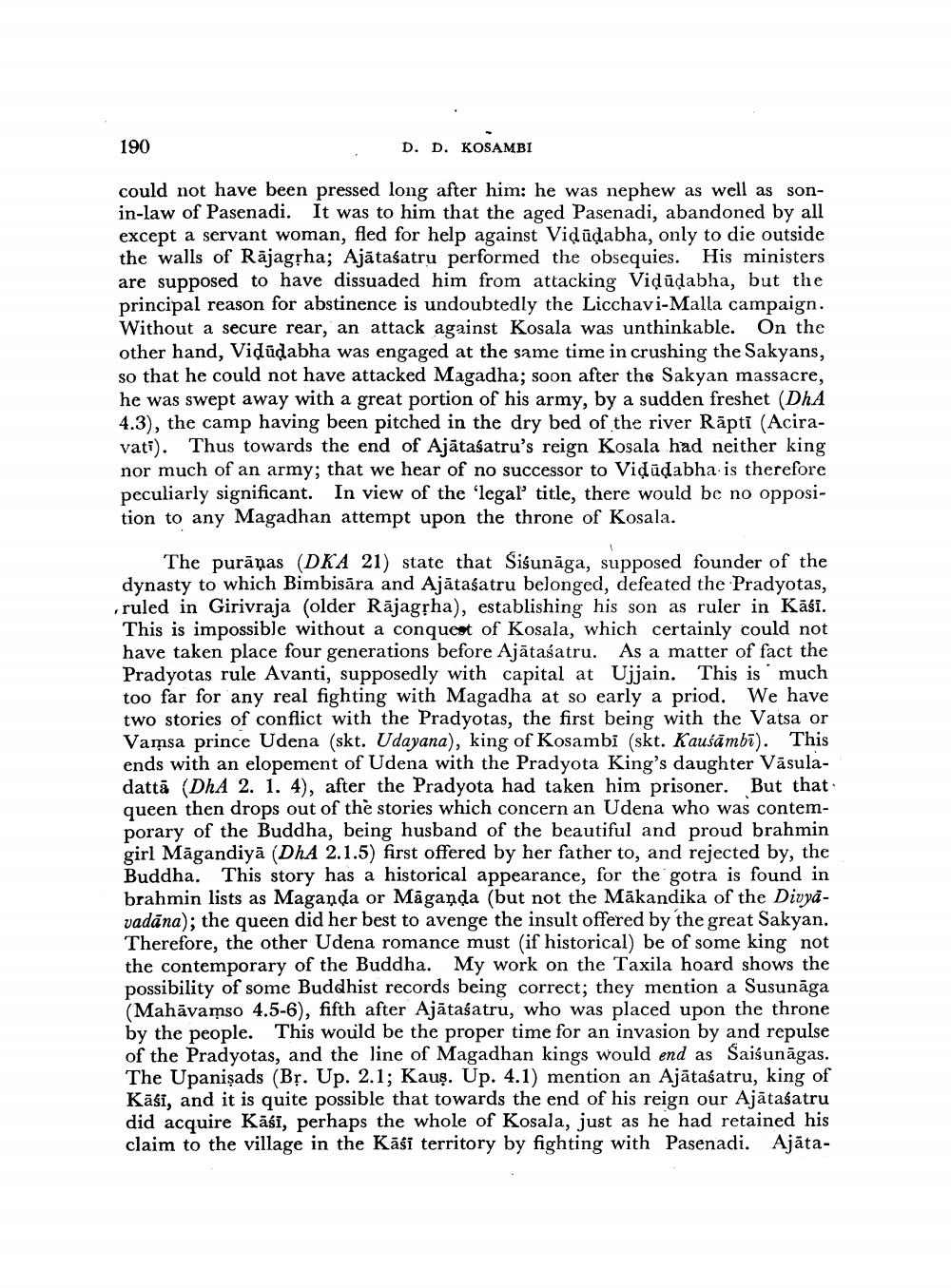________________
190
D. D. KOSAMBI
could not have been pressed long after him: he was nephew as well as sonin-law of Pasenadi. It was to him that the aged Pasenadi, abandoned by all except a servant woman, fled for help against Viļūdabha, only to die outside the walls of Rājagpha; Ajātasatru performed the obsequies. His ministers are supposed to have dissuaded him from attacking Vidūdabha, but the principal reason for abstinence is undoubtedly the Licchavi-Malla campaign. Without a secure rear, an attack against Kosala was unthinkable. On the other hand, Viļūdabha was engaged at the same time in crushing the Sakyans, so that he could not have attacked Magadha; soon after the Sakyan massacre, he was swept away with a great portion of his army, by a sudden freshet (DhA 4.3), the camp having been pitched in the dry bed of the river Rāpti (Aciravati). Thus towards the end of Ajātaśatru's reign Kosala had neither king nor much of an army; that we hear of no successor to Viļūdabha is therefore peculiarly significant. In view of the 'legal' title, there would be no opposition to any Magadhan attempt upon the throne of Kosala.
atasatru bishing his son certainly
of the stoc Pradyota had takena King's daughter Vis
The purāņas (DKA 21) state that Siśunāga, supposed founder of the dynasty to which Bimbisāra and Ajātasatru belonged, defeated the Pradyotas, ruled in Girivraja (older Rājagpha), establishing his son as ruler in Kāśi. This is impossible without a conquest of Kosala, which certainly could not have taken place four generations before Ajātasatru. As a matter of fact the Pradyotas rule Avanti, supposedly with capital at Ujjain. This is much too far for any real fighting with Magadha at so early a priod. We have two stories of conflict with the Pradyotas, the first being with the Vatsa or Vamsa prince Udena (skt. Udayana), king of Kosambi (skt. Kaušāmbī). This ends with an elopement of Udena with the Pradyota King's daughter Väsuladattā (DhA 2. 1. 4), after the Pradyota had taken him prisoner. But that queen then drops out of the stories which concern an Udena who was contemporary of the Buddha, being husband of the beautiful and proud brahmin girl Māgandiyā (DhA 2.1.5) first offered by her father to, and rejected by, the Buddha. This story has a historical appearance, for the gotra is found in brahmin lists as Maganda or Maganda (but not the Mākandika of the Divyavadāna); the queen did her best to avenge the insult offered by the great Sakyan. Therefore, the other Udena romance must (if historical) be of some king not the contemporary of the Buddha. My work on the Taxila hoard shows the possibility of some Buddhist records being correct; they mention a Susunāga (Mahāvamso 4.5-6), fifth after Ajātaśatru, who was placed upon the throne by the people. This would be the proper time for an invasion by and repulse of the Pradyotas, and the line of Magadhan kings would end as Saiśunāgas. The Upanişads (Bș. Up. 2.1; Kauş. Up. 4.1) mention an Ajātaśatru, king of Kāsi, and it is quite possible that towards the end of his reign our Ajātasatru did acquire Kāsi, perhaps the whole of Kosala, just as he had retained his claim to the village in the Kāśi territory by fighting with Pasenadi. Ajāta




